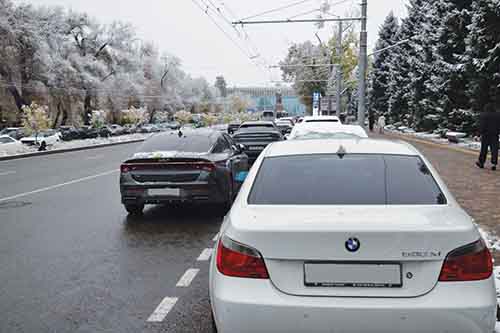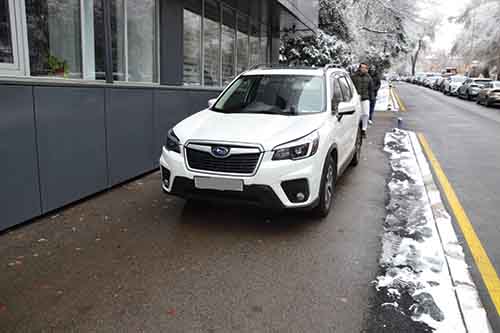The cost of parking near KIMEP
Students losing time, nerves and money as they search for a place to stop
Every morning near KIMEP University, a real battle for parking breaks out.
For Ayazhan Kaiypzhan, who graduated from KIMEP in the summer, parking near campus was a “survival game.”
“Every day, I had to circle around several times looking for a free space and end up being late for classes,” she said.
The streets are so filled with commuting students, that some students resort to parking illegally or creating a second row of parked cars, blocking in the first car. Traditionally, people will leave a note on the blocked car with their phone number so that the first person parked (or worse, the police) can call and they can move their car.
Even those who resort to forced measures and leave their cars in the second row do not feel comfortable.
Yulia Lim, a fourth-year student, said sometimes there are not even illegal spaces.
“Sometimes there are no spaces even in the second row,” Lim said. “Some people park incorrectly, taking up a lot of space.”
Worse yet, even when a student parks next to another car and leaves a note, they spend much of their time on campus and in classes distracted.
“Leaving the car in the second row, you always sit during class waiting for the call,” Lim said.
With only 400 students living on campus and another 1,500 students commuting, the 60 spaces allocated to students is not enough. While many students use public trolley buses and buses, as well as the steady stream of Yandex users getting dropped off in front of Valikhanov, many students either can’t use public transportation or don’t want to.
Additionally, due to the construction of the College of Computer Sciences and Mathematics building, those 60 spaces are unavailable, administration officials said.
Natalia Tegenbaeva, director of the KIMEP Facilities Management Department, said, the internal parking had to be closed due to construction and the completion date of the project remains unclear. It was announced that the parking will be available on Nov. 15, but that day has come and gone and the parking spots remain unavailable.
Even when those 60 spots become available, there is a waiting list of 121 students requesting a spot, the university said. According to KIMEP’s website, a parking spot on campus costs 7,500 tenge a month, which a student will spend more parking on a public street in eight days. With parking fines starting at 8,000 tenge, if a student accumulates 10 fines, that costs as much as it would to purchase parking on campus for a year.
While the price for on-campus parking sounds like a dream, the wait will cause nightmares.
Tegenbaeva said that in the past when she has called people on the waiting list to tell them that they can now park on campus, she has learned that the student has already graduated.
Currently, there are no plans to build a parking lot or parking deck on campus property, Tegenbaeva said.
That leaves KIMEP under siege in a sea of vehicles along Abay, Valikhanov, and Dostyk streets. Cars are parked in several rows and on all sides. Spaces along Valikhanov and Dostyk are taken before the sun rises on a school day. Cars parked along Valikhanov, Dostyk and Abay take up every available meter.

“The problem is that there are no parking spaces, there are a lot of cars, but few spaces,” said Zhanel Sagyndyk, a third-year student. “People somehow park on both sides of the street, which worsens the situation for driving in and out of there.”
Abay Street also often turns into chaos.
“On Abay, people leave their cars, literally barricading each other,” adds Sagyndyk. She said she believes the university should think about larger-scale solutions, for example, building a multi-level parking lot inside the campus.
“If there is land that can be used, we could build a two- or three-story parking lot,” she said. “Of course, I’m not sure that there is land left for this, but it would be cool.”
Students who do not have time to get a place near the university are forced to look for alternatives.
Symbat Bolatbek, a second-year student, said she now leaves her car in the Colibri parking lot because she can’t find a spot on any street or doesn’t have the time to look.
“My classes start at lunchtime, so when I arrive, there are no spaces at all,” said Bolatbek. “Colibri is expensive 2 to 3-thousand tenge per day, just to park for a few hours.”
“I have a disabled sign on my car, but near KIMEP there are only two disabled parking spaces, which are absolutely always occupied by people who should not park there,” she said.
Nevertheless, students continue to hope for an improvement in the situation.
Venera Abdildabekova said she believes adding additional parking spaces on campus would be the best solution.
“I would like to see another parking lot open, so that it would be easier for students,” she said.
Kaiypzhan agrees. While she never tried to get a coveted on-campus space, she said the only solution is increasing the number of parking spaces on campus.
“This problem needs to be solved,” she said.

